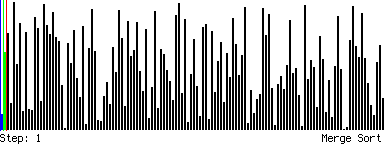Merge sort is a recursive sorting algorithm and, luckily for us, it’s quite a bit faster than bubble sort. Merge sort is a divide and conquer algorithm.
Divide 🔗
- Divide the input slice into two (equal) halves
- Recursively sort the two halves
Conquer 🔗
- Merge the two halves to form a sorted array

Full example of the merge sort algorithm 🔗
Merge sort actually has two functions involved, the recursive mergeSort function, and the merge function.
Let’s write the mergeSort() function first. It’s a recursive function, which means it calls itself, and in this case, it actually calls itself twice. The point of the mergeSort function is to split the array into two roughly equal parts, call itself on those parts, then call merge() to fit those halves back together.
func mergeSort(items []int) []int {
if len(items) < 2 {
return items
}
first := mergeSort(items[:len(items)/2])
second := mergeSort(items[len(items)/2:])
return merge(first, second)
}
The merge() function is used for merging two sorted lists back into a single sorted list, its where the “magic” really happens. At the lowest level of recursion, the two “sorted” lists will each have a length of 1. Those single element lists will be merged into a sorted list of length two, and we can build of from there.
func merge(a []int, b []int) []int {
final := []int{}
i := 0
j := 0
for i < len(a) && j < len(b) {
if a[i] < b[j] {
final = append(final, a[i])
i++
} else {
final = append(final, b[j])
j++
}
}
for ; i < len(a); i++ {
final = append(final, a[i])
}
for ; j < len(b); j++ {
final = append(final, b[j])
}
return final
}
Using the algorithm in code 🔗
func main() {
unsorted := []int{10, 6, 2, 1, 5, 8, 3, 4, 7, 9}
sorted := mergeSort(unsortedInput)
// sorted = [1, 2, 3, 4, 5, 6, 7, 8, 9, 10]
}
Why use merge sort? 🔗
Pros 🔗
- Fast. Merge sort is much faster than bubble sort, being
O(n*log(n))instead ofO(n^2). - Stable. Merge sort is also a stable sort which means that values with duplicate keys in the original list will be in the same order in the sorted list.
Cons 🔗
- Extra memory. Most sorting algorithms can be performed using a single copy of the original array. Merge sort requires an extra array in memory to merge the sorted subarrays.
- Recursive: Merge sort requires many recursive function calls, and function calls can have significant resource overhead.
If you need a sorting algorithm to use in a production system, I recommend not reinventing the wheel and using the built-in sort.Sort method.
Merge sort Big-O complexity 🔗
Merge sort has a complexity of O(n*log(n)). Don’t be fooled because there aren’t an explicit number of for-loops to count in the code. In merge sort’s case, the number of recursive function calls is important.
PS: I’ve got two courses if you want to dig in deeper to this stuff:




